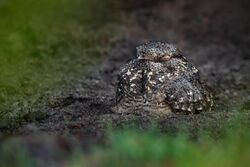Biology:Savanna nightjar
| Savanna nightjar | |
|---|---|

| |
| File:20190214-SavannahNightjarUdaipur.ogg | |
| Scientific classification | |
| Domain: | Eukaryota |
| Kingdom: | Animalia |
| Phylum: | Chordata |
| Class: | Aves |
| Clade: | Strisores |
| Order: | Caprimulgiformes |
| Family: | Caprimulgidae |
| Genus: | Caprimulgus |
| Species: | C. affinis
|
| Binomial name | |
| Caprimulgus affinis Horsfield, 1821
| |
The savanna nightjar, sometimes also allied nightjar or Franklin's nightjar, (Caprimulgus affinis) is a species of nightjar found in South and Southeast Asia. Six subspecies are recognised: C. a. monticolus, C. a. amoyensis, C. a. stictomus, C. a. affinis, C. a. timorensis and C. a. propinquus. It was once considered conspecific with the chirruping nightjar.[2] The IUCN Red List has assessed the species to be of least concern because it has a large range and its population trend is stable.[1]
Habitat
Its habitat is open forest and areas with scrub.[3] However, it has recently moved gradually into the metropolitan areas of Taiwan, probably due to the absence of natural predators in that setting. Habitat loss is likely also a significant factor. Impacts of this relocation have included disturbed sleep for residents—due to male savanna nightjars' loud vocalizations at night from January to July—and collisions with aircraft. It is predicted to continue this habitat shift and expand its range into all major western Taiwanese cities.[4]
Description
Its length is about 25 cm (9.8 in), with a wingspan of 64 cm and a body weight of 54-110g.[4] The upperparts are brownish-grey and vermiculated, with pale brown speckles. The underparts are brown, with bars.[5] The savanna nightjar is nocturnal and is recognizable by its characteristic loud chirping calls, mainly given in flight during the evening.[5] Their acoustic features change and can preadapt based upon their habitat.[6]
References
- ↑ 1.0 1.1 BirdLife International (2016). "Caprimulgus affinis". IUCN Red List of Threatened Species 2016: e.T22689985A93255114. doi:10.2305/IUCN.UK.2016-3.RLTS.T22689985A93255114.en. https://www.iucnredlist.org/species/22689985/93255114. Retrieved 11 November 2021.
- ↑ IOC World Bird List (v 13.2). 2023. doi:10.14344/IOC.ML.13.2. http://www.worldbirdnames.org/.
- ↑ Grimmett, Richard; Inskipp, Carol; Inskipp, Tim (2013). Birds of the Indian Subcontinent. Bloomsbury Publishing. p. 228. ISBN 9781408162644. https://books.google.com/books?id=kMwXBAAAQBAJ&pg=PA228.
- ↑ 4.0 4.1 Cheng, Bai-You; Shyu, Guey-Shin; Wu, Shi-Ching; Lin, Hsiao-Hsien; Hsu, Chia-Hsuan; LePage, Ben; Fang, Wei-Ta (2019-03-25). "Fragmented Riverine Habitats in Taiwan Have Spatio-Temporal Consequences, Re-Distributing Caprimulgus affinis into Urban Areas Leading to a Human–Wildlife Conflict". Sustainability 11 (6): 1778. doi:10.3390/su11061778. ISSN 2071-1050.
- ↑ 5.0 5.1 Myers, Susan (2016). Wildlife of Southeast Asia. Princeton University Press. p. 78. ISBN 9781400880720. https://books.google.com/books?id=i428CwAAQBAJ&pg=PA78.
- ↑ Liang, Shih-Hsiung; Walther, Bruno Andreas; Jen, Chia-Hung; Chen, Chao-Chieh; Chen, Yi-Chih; Shieh, Bao-Sen (2020-10-23). "Acoustic preadaptation to transmit vocal individuality of savanna nightjars in noisy urban environments". Scientific Reports 10 (1): 18159. doi:10.1038/s41598-020-75371-4. ISSN 2045-2322. PMID 33097822. PMC 7584573. http://dx.doi.org/10.1038/s41598-020-75371-4.
Wikidata ☰ Q512949 entry
 |


